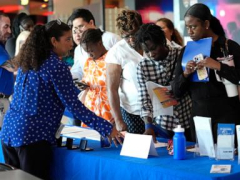WASHINGTON — Friday’s monthly jobs report will likely mark a pivotal moment for the economy and the Federal Reserve.
If it shows that hiring was weak in August and that the unemployment rate rose — similar to the unexpectedly soft figures for July — it would heighten worries that the job market is stumbling. The Fed might then seek to deliver a stimulus with a larger-than-usual interest rate cut of a half-percentage point when it meets later this month.
If, on the other hand, hiring picked up from July’s gain of just 114,000 or if the unemployment rate fell from 4.3% — the highest level in three years, though still low by historical standards — it would suggest that the labor market remain stable, though slowing. The Fed would probably cut its key rate from its 23-year high by a more modest quarter-point, with further rate cuts to follow in the coming months.
Either outcome could also help shape the remaining two months of the presidential race. Another sluggish hiring report would fuel former President Donald Trump’s claims that the Biden-Harris administration has overseen a worsening economy.
A healthier report, though, would arm Vice President Kamala Harris with evidence that the job market is still motoring ahead even while inflation has tumbled from a four-decade peak to near the Fed’s 2% target, opening the door to rate cuts. Reductions in the Fed’s benchmark rate will eventually lead to lower borrowing costs for a range of consumer and business loans, including mortgages, auto loans and credit cards.
The two presidential nominees outlined dueling economic plans in speeches this week, with Trump promising to cut corporate taxes to 15% and eliminate taxes on tips and Social Security income. Harris has vowed to expand tax deductions for start-up companies while raising the corporate tax rate to 28%.
Economists have estimated that the government will report Friday that employers added 160,000 jobs in August and that the unemployment rate slipped back to 4.2%. Since hitting a half-century low of 3.4% in April of last year, the jobless rate has risen nearly a full percentage point.
Most of the rise in the jobless rate, though, reflects an influx of people into the labor force — notably, recent immigr





